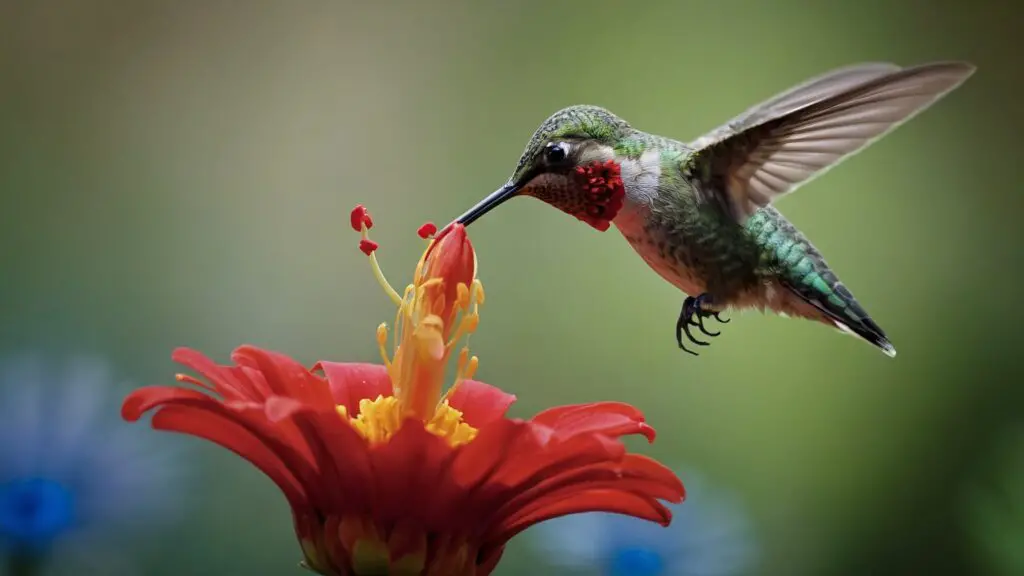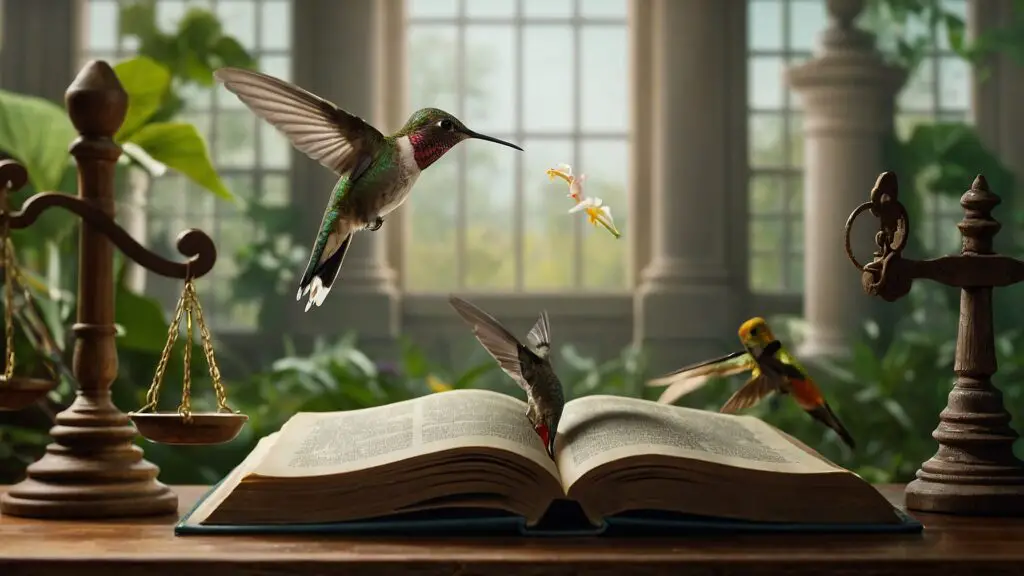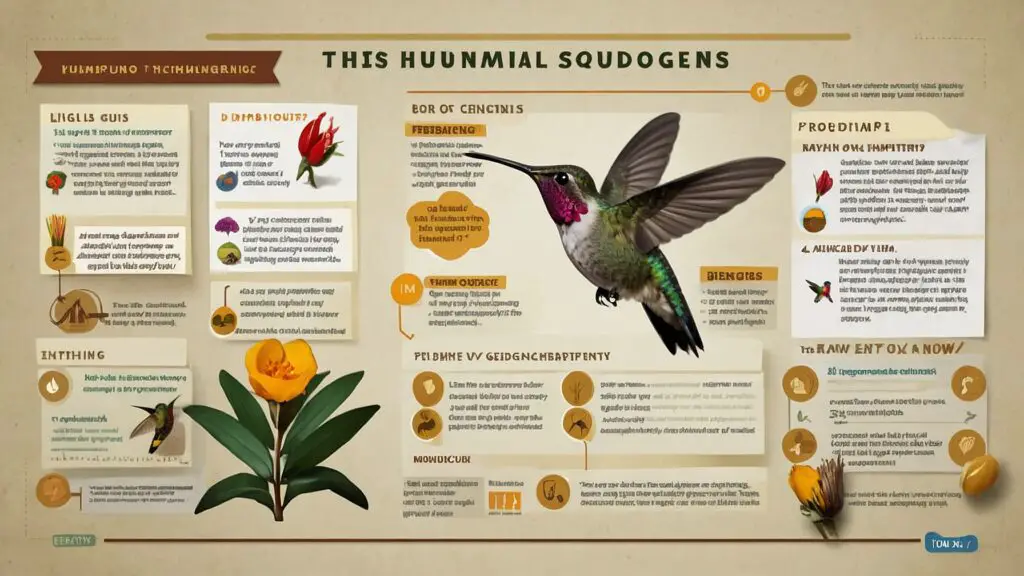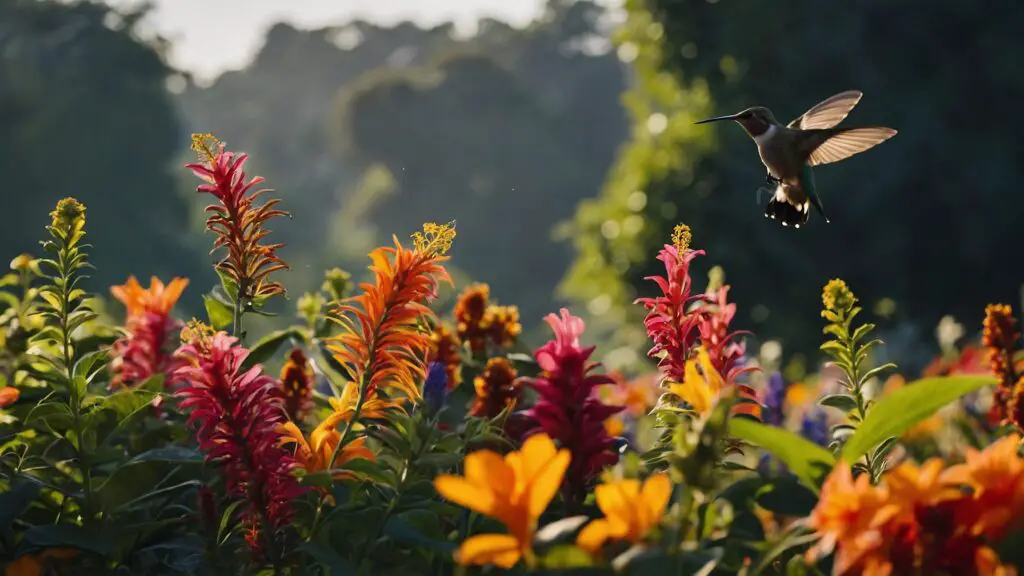Estimated reading time: 26 minutes
Introduction
The fascination with transforming a hummingbird into a pet stems from their magical presence in our gardens and the sheer joy they bring as they dart from flower to flower. Yet, when pondering the question, “can you have a hummingbird as a pet,” we must tread carefully on the fine line between admiration and the desire for possession. Hummingbirds, with their dazzling colors and rapid, almost invisible wing beats, represent the wild’s untamed beauty. As we explore the possibility of keeping such a creature, it’s vital to consider not just the enchantment they hold for us but also the ethical considerations and natural behaviors that make hummingbirds as pets a complex issue. Understanding the hummingbird’s lifespan in captivity versus their natural environment provides a stark perspective on the implications of domesticating these free spirits. This journey into the feasibility of a domesticated hummingbird challenges us to reflect on our motivations and the potential impact on these avian wonders.
Diving deeper into whether hummingbirds can be kept as pets, it becomes clear that the essence of what makes these birds so captivating—their freedom, their role in the ecosystem, and their complex natural behaviors—cannot be replicated within the confines of a home. The legal and ethical barriers, underscored by regulations such as the Migratory Bird Treaty Act, further illustrate the complexities of turning a hummingbird into a pet. This discussion goes beyond a simple yes or no answer to “can you own a hummingbird,” inviting readers to appreciate these creatures in their natural habitat. By promoting a respectful distance, we can enjoy the beauty and wonder of hummingbirds without diminishing their quality of life. The narrative weaves a compelling argument, urging us to consider if the desire to have a hummingbird pet aligns with the best interests of these jeweled flyers and the natural world they are an integral part of.
Key Takeaways
- Exploring the Desire for Hummingbird Companionship: The allure of hummingbirds as pets stems from their enchanting presence, but we must weigh our fascination against the ethical and legal implications of domesticating such free-spirited creatures.
- Understanding the Complexity of Hummingbird Care: Properly caring for a hummingbird, with its high-energy needs and specific dietary requirements, proves challenging and far from the simplicity some might expect.
- Legal Barriers to Hummingbird Domestication: The Migratory Bird Treaty Act highlights the legal constraints, making it unlawful to keep hummingbirds as pets, thereby protecting these birds under international and national conservation laws.
- The Ethical Debate on Wild Animals as Pets: Keeping hummingbirds in captivity raises significant ethical concerns, emphasizing the importance of appreciation over possession and the cruelty of depriving them of their natural behaviors and environment.
- Contributing to Conservation Instead of Captivity: Encourages supporting hummingbird conservation efforts and creating hummingbird-friendly gardens as ethical alternatives to keeping these birds as pets.
- Promoting a Respectful Coexistence: Highlights the importance of respecting hummingbirds’ freedom and their role in the ecosystem, advocating for a respectful distance and coexistence with these remarkable creatures.
- Dispelling Myths About Hummingbird Care: Debunks common misconceptions, clarifying that hummingbirds require a balanced diet beyond sugar water and that their wild nature cannot be tamed for domestic life.
- Advocating for Education and Advocacy: Stresses the importance of spreading knowledge about hummingbirds and their conservation, inspiring collective efforts towards protecting these birds and their habitats.
The Allure of the Hummingbird
The allure of the hummingbird, with its captivating flight and vibrant colors, poses the enchanting question: can you have a hummingbird as pets? This query taps into the desire to keep these avian wonders close, to observe their beauty daily. However, the reality of bringing a hummingbird into captivity challenges our understanding of what it means to truly appreciate these creatures. Despite the fascination, the complexities surrounding the care, legalities, and ethical considerations of having a hummingbird for a pet reveal a deeper truth. Laws such as those enforced by the wildlife service make it clear that in many places, it is not legal to own a hummingbird.
This serves as a reminder that some beauties of nature are best admired from a distance, ensuring they remain unfettered and thriving in their natural habitats. Thus, while the dream of keeping a pet hummingbird may persist, it underscores the importance of conservation and respect for the natural world, reminding us that not all wishes should be pursued if they compromise the well-being of such incredible creatures.
A Glimpse into the Life of a Hummingbird
Before we dive into the main question—can you have a hummingbird as a pet—it’s worth understanding these birds.
- Migration Marvels: Did you know some hummingbirds migrate over 2,000 miles? The Ruby-throated hummingbird, for example, flies non-stop over the Gulf of Mexico!
- High Energy Needs: These birds have an extremely high metabolism, requiring them to eat many times their weight in food each day. Their primary diet? Nectar from flowers, supplemented by insects for protein.
- Hovering Helicopters: One of the few birds that can hover in mid-air, hummingbirds achieve this with wind speeds of up to 80 flaps per second.
I remember my first encounter with a hummingbird. I was sitting on my porch, reading a book, when a bright flash of green and red darted in front of me—Time seemed to freeze momentarily as I watched this tiny bird hover near a flower, sipping nectar. It was a magical experience that made me understand why so many are enamored with these creatures.
So, Why the Desire to Keep Them Close?
The enchantment with hummingbirds, those iridescent marvels of nature, often ignites a deep-seated yearning to bridge the gap between human and avian worlds. This allure is not just about their beauty or the mesmerizing way they hover in mid-air; it’s about the connection we feel to the natural world when a hummingbird zips up close, inspecting us with curiosity. Questions like “can I have a hummingbird as a pet” or “can you own hummingbirds” stem from a wish to make this fleeting interaction a permanent part of our lives.
Yet, this desire confronts a complex reality of legal, ethical, and care-related considerations. The legal framework, highlighted by inquiries into is it legal to own a hummingbird, points to a significant barrier, emphasizing the importance of adhering to wildlife protection laws. Moreover, understanding the hummingbird’s lifespan in captivity versus their natural habitat invites a reconsideration of our wishes against the backdrop of ethical stewardship. It’s a reminder that sometimes, admiration from afar contributes more to the preservation of their mysterious world than any attempt to bring them into our own.

Understanding Hummingbirds: More Than Just Pretty Birds
Understanding Hummingbirds: More Than Just Pretty Birds delves into the essence of these avian spectacles beyond their luminous plumage. Hummingbirds, often considered for companionship with questions like “can a hummingbird be a pet” or “can you keep a hummingbird as a pet,” reveal the complexities of their existence beyond mere aesthetic value. These creatures are not just about visual appeal; they embody the pinnacle of evolutionary success, displaying remarkable physical and behavioral adaptations that allow them to navigate the world in ways unparalleled by other species.
The inquiry into keeping one as a pet often overlooks these intricate realities, including the hummingbird lifespan in captivity versus their free, unbounded life. It’s crucial to acknowledge that despite the legal and ethical implications surrounding the captive keeping of these birds—underscored by laws rendering it illegal to keep a pet in the United States—our fascination should pivot towards conservation. This shift in perspective honors their role in our ecosystem, emphasizing that admiration from afar might be the most profound form of appreciation, safeguarding their freedom and the intricate dance of their existence.
The Unique Biology of Hummingbirds as aviary
When you delve into the biological intricacies of hummingbirds, you’ll uncover a treasure trove of fascinating facts. Let’s explore:
- Fast Metabolism: To sustain their rapid lifestyle, hummingbirds have developed one of the highest metabolic rates of any bird species. Imagine your heart racing at a staggering 1,260 beats per minute! With its speedy heart, this tiny dynamo needs to consume an amount equivalent to nearly half its body weight in food daily. That’s akin to a human eating around 100 pounds of food daily!
- Migratory Marvels: Not all hummingbirds migrate, but those exhibit immense endurance. Picture the Ruby-throated hummingbird, a bird weighing no more than a nickel, covering a migratory span between North America and Central America. These thousands of miles often involve non-stop flights, showcasing their exceptional stamina.
I set up a hummingbird feeder in my backyard a few summers ago. It became a pit stop for a variety of hummingbirds. I was particularly intrigued by one with a ruby-red throat. After some research and observations, I realized it was the Ruby-throated hummingbird. Learning about its migratory journey gave me a newfound respect for this tiny powerhouse.
The Natural Habitat of Hummingbirds in Wildlife
The habitats of hummingbirds are as varied as their species, but they all share common elements that cater to their lifestyle and dietary needs.
- Flower Nectar: A hummingbird’s primary diet is flower nectar, which provides them with the sugars they need for energy. Their long, specialized beaks, almost like nature’s straw, are perfectly evolved to extract nectar from flowers. And their equally long tongues lap up the sweet liquid, sometimes at 13 licks per second!
- Open Spaces & Sheltered Nooks: While hummingbirds love darting in open spaces, demonstrating acrobatic feats in mid-air, they also need sheltered nooks for nesting and protection. These agile birds are adept at zipping around in open areas to avoid predators, find mates, and seek out the best flowers for nectar. Yet, when it’s time to lay eggs or take a brief respite, they opt for denser foliage or shrubbery.
- Presence Across Continents: From the meadows of North America to the forests of South America, hummingbirds have made a home in diverse landscapes. Their habitats range from sea level up to altitudes of 14,000 feet in the South American Andes.
Did you know? Hummingbirds are strictly found in the Americas! These birds have spread their wings across diverse landscapes from Alaska to Tierra del Fuego.
To truly understand and appreciate hummingbirds, it’s essential to go beyond their shimmering exterior and delve deep into their biology and behavior. By understanding their needs and natural habits, one can understand why keeping them as pets might be far from ideal.
The Legality of Keeping a Humming bird as a Pet
While the allure of having a hummingbird as a pet is undeniable, it’s paramount to understand that the reality of such a desire is intertwined with legal and ethical constraints. In many regions, particularly within the United States, it’s illegal to keep a hummingbird as a pet, a regulation underscored by laws designed to protect these delicate birds and their ecosystems. This legal stance isn’t just a bureaucratic hurdle; it reflects a broader understanding of hummingbirds’ needs—from their diet to their unique behavior, such as the ability to hold a humming bird pet or find a hummingbird on the ground, which requires specific knowledge and care that a typical household cannot provide.
The truth that hummingbirds cannot be domesticated for personal enjoyment without compromising their well-being is a poignant reminder of our responsibility towards these natural wonders. It emphasizes that while we may possess the capability to create an aviary or purchase baby hummingbird supplies, the ethical choice is to appreciate them in their natural habitat, where they truly belong.
In the United States it is against the law/ illegal to hold a hummingbird, a hummingbird nest, a hummingbird baby, or any part of a hummingbird, nest, or egg, in any type of captivity.
Dive into the U.S. legal system, and you’ll find that birds, especially the migratory ones, hold a special status. Let’s break down the law:
- Migratory Bird Treaty Act (MBTA): Established in 1918, the MBTA makes it unlawful to pursue, hunt, take, capture, or kill; attempt to take, capture, or kill; possess, offer to or sell, barter, purchase, deliver, or cause to be shipped, exported, imported, transported, carried, or received any migratory bird, part, nest, egg or product, manufactured or not. This exhaustive law covers every aspect of a bird’s existence and is designed to protect our feathered friends.
- Hummingbirds and the MBTA: Hummingbirds fall under this act. Meaning it’s illegal to possess, transport, or sell a hummingbird, its nest, eggs, or even its feathers. Violation of this act can result in hefty fines.
I once attended a local bird-watching group where a member shared a touching story. They had found an injured hummingbird, and rather than keeping it, they contacted a licensed rehabilitation expert to ensure its safety and health. The bird’s freedom and protection were prioritized even in that vulnerable state.
Hummingbirds are protected under the Migratory Bird Treaty Act, which makes it illegal to capture, kill, or possess any migratory bird, including hummingbirds, without a valid permit.
While the U.S. has the MBTA, many countries have instituted laws and treaties to protect their native and migratory birds.
- Convention on the Conservation of Migratory Species of Wild Animals (CMS): Often referred to as the Bonn Convention, it aims to conserve terrestrial, marine, and avian migratory species throughout their range. This international treaty ensures that countries cooperate to support migratory species.
- Country-Specific Laws: Many nations have dedicated laws that shield birds from harm, from Canada’s Migratory Birds Convention Act to Australia’s Environment Protection and Biodiversity Conservation Act. In essence, these laws recognize the ecological importance of birds, including hummingbirds, and strive to prevent their unlawful capture, trade, or possession.
Did you know? The hummingbird’s role in pollination is invaluable. In places like Costa Rica, where eco-tourism is prevalent, hummingbirds play a pivotal role in maintaining the ecological balance. Laws protecting these birds indirectly help in conserving entire ecosystems!
While the mesmerizing dance of the hummingbird might be a sight to behold, these birds are meant to be free. Respecting international and local laws is just a starting point. Beyond the legal aspect, understanding and appreciating the importance of these birds in our ecosystem underscores the larger narrative of conservation and ethical responsibility.

Ethical Concerns About Pet Hummingbirds: Why It’s Not Just About the Law
Why It’s Not Just About the Law delves deeper than the black-and-white legalities of whether hummingbirds can be kept as pets. It ventures into the ethical considerations that come with the desire to bring these vibrant creatures into our homes. While the law may dictate that keeping a hummingbird in captivity is not permissible in many areas, including the United States, the ethical perspective questions the morality and compassion behind our actions. The essence of ethical stewardship goes beyond the question of “can you own a hummingbird as a pet” to ponder the needs and well-being of these delicate birds.
Hummingbirds aren’t just objects of beauty to be displayed but sentient beings with complex needs, from their specific dietary requirements to their instinctual behaviors like nest building and territory defense. The fact that hummingbirds cannot be kept as pets without compromising their natural behaviors and lifestyle is a stark reminder that our admiration should not lead to possession. Instead, ethical considerations should guide us to respect their freedom and inherent rights to live unconfined, urging us to admire these creatures from a distance and support conservation efforts that protect their natural habitats.
The Cruelty of Captivity for Hummingbird for Pet
Let’s take a moment and put ourselves in their tiny, fast-beating hearts. Hummingbirds, by nature, are wanderers of the sky. They zigzag through air currents, travel vast distances, and have the world as their playground.
The Limitations of Captivity:
- Limited Flight: In captivity, their vibrant wings, which beat up to 80 times per second, are confined. No matter how spacious, a cage is still a prison for these agile birds.
- Altered Diets: In the wild, they feed on various flowers, extracting nectar and playing a crucial role in pollination. In captivity, their diets can become monotonous and lack essential nutrients.
- Social Deprivation: Hummingbirds are not solitary creatures. They have specific mating rituals, territorial displays, and social interactions that cannot be mimicked in captivity.
I chanced upon a wildlife rehabilitation center on a trip to Central America. Here, injured birds, including hummingbirds, were nursed back to health. One hummingbird with an injured wing was in recovery. Though the caregivers provided the best environment, the bird’s spirit seemed subdued. Every morning, it would perch at the edge of its enclosure, watching its free brethren zip and zoom. It was a poignant reminder that freedom is an irreplaceable joy.
The Responsibility of Animal Lovers for Pet Humming bird
Those who genuinely love and respect animals often grapple with a fundamental principle: appreciation over possession. It’s about understanding that our affection for these creatures shouldn’t come at the cost of their natural lives.
Guiding Principles for True Animal Enthusiasts:
- Observe, Don’t Disturb: The joy of watching a hummingbird in the wild, its natural habitat, is incomparable to seeing one in captivity. It’s the difference between watching a bird and truly seeing it.
- Educate and Advocate: Sharing knowledge about the importance of letting wild animals remain wild can ripple into broader awareness and positive action.
- Support Conservation Efforts: Instead of keeping a hummingbird, consider supporting sanctuaries, conservation areas, or initiatives that protect their habitats.
I was gifted a beautiful bird in a cage years ago. Though it sang sweetly every morning, there was a discernible sadness. It took me time, but I realized my joy shouldn’t stem from possession. I let it go, and the sight of it soaring high was more fulfilling than any song it sang in captivity. Similarly, genuine love for hummingbirds—or any animal—means letting them live freely, as nature intended.
The Reality of Caring for a Hummingbird
Despite their allure, hummingbirds are wild animals, with specific needs that extend far beyond the aesthetics of their iridescent feathers. In the United States, the legal framework, including regulations by the Fish and Wildlife Service and protections under the Migratory Bird Treaty Act, underscores that it’s not only illegal to keep hummingbirds as pets but also illegal to capture or buy hummingbird eggs. These laws reflect the understanding that hummingbirds have intricate needs—from creating a hummingbird nest to finding specialized food—which cannot be adequately met in a home environment.
ven the act of trying to hold a hummingbird or touch a hummingbird can be detrimental to their well-being. For those who encounter an injured or abandoned hummingbird, the compassionate and legal action is to contact a wildlife rehabilitator, professionals who are equipped to provide the care these sensitive birds require. This emphasizes that our fascination should be matched with respect for their natural habits and legal protection, affirming that truly loving wildlife means letting it remain wild.
Dietary Needs and Challenges
Feeding a hummingbird is not as straightforward as you might think. Simply offering sugar water doesn’t cut it; their diet is multifaceted. Each component plays a crucial role in ensuring they stay vibrant and healthy.
Dietary Component:
- Flower Nectar: This is not just food; it’s their rocket fuel. The high sugar content provides their energy for their super-fast wing beats.
- Why It’s Important: It’s their primary source of energy. Without it, they wouldn’t have the stamina to fly, let alone perform their aerial acrobatics.
- Insects: Those rapid movements aren’t powered by sugar alone. Insects play an often overlooked but critical role in their diet.
- Why It’s Important: They provide essential proteins and fats for muscle repair and growth.
During one of my garden bird-watching sessions, I saw a hummingbird expertly snagging tiny insects in mid-air. It was a clear reminder that these birds are more than just nectar fans; they are skilled insect hunters, too!
Table: The Comprehensive Diet of a Hummingbird
| Dietary Component | Importance | Examples |
|---|---|---|
| Flower Nectar | Energy | Azaleas, bee balm, sage |
| Insects | Protein & Fat | Aphids, gnats, spiders |
Environmental Needs
At the heart of it, hummingbirds are wild spirits. Born to be free, born to soar. More than one might initially realize, their environment plays a pivotal role in their well-being.
- Space: Imagine being an F1 racer, but you’re told to only drive in your backyard. That’s what a cage feels like to a hummingbird.
- Why It’s Essential: They are designed for agility and speed. The open sky is their playground, where they execute dazzling maneuvers.
- Stimulating Surroundings: It’s not just about the space. It’s about the quality of the area.
- Why It’s Essential: Hummingbirds thrive in environments rich in flowers, plants, and other creatures. Such surroundings offer food and mental stimulation as they constantly decide where to feed, which flowers to visit, and how to interact with other birds.
- Safety from Predators: Their quick reflexes help them evade threats in the wild. In a confined space, they’re sitting ducks.
- Why It’s Essential: Safety ensures they can rest without stress, which is essential for their health and well-being.
A friend once tried to create a “hummingbird-friendly” patio, complete with feeders and plants. However, she noticed that local cats became frequent visitors, lurking and watching. The hummingbirds, sensing danger, eventually stopped coming. This incident was a stark reminder that while we might have the best intentions, nature has its rhythm and balance.
While the allure of having a hummingbird close is tempting, their intricate needs make them ill-suited for domestication. It is crucial to understand and respect the vast gulf between admiring their beauty and providing them with the life they truly deserve. Remember, genuine appreciation is letting them flourish in the wild, where they truly belong.

Famous Myths and Misconceptions Debunked
Top 3 Myths and Misconceptions:
- can hummingbirds be pets
- can you have a pet hummingbird
- can you have hummingbirds as pets
A common misconception is that can hummingbirds be kept as pets, which many enthusiasts dream of due to their allure and grace. However, it’s crucial to understand that in many places, including extensive parts of the United States, it is not legally permissible to have a pet hummingbird or can you buy a hummingbird as a pet. These regulations exist not to curtail the joy these creatures bring but to protect them, ensuring their survival and well-being in the wild. The belief that one can easily have hummingbirds as pets overlooks their complex needs, from specialized diets to their intrinsic need for vast spaces to fly freely. By dispelling these myths, we foster a deeper appreciation for hummingbirds in their natural habitat, encouraging conservation over captivity and respect for their role in our ecosystems.
“I Can Tame a Pet Hummingbird!”
Truth Bomb: Hummingbirds may be tiny, but they pack a punch of wildness. Yes, they might hover around you, especially if you’re near their favorite feeder, but don’t mistake this proximity for genuine trust or affection. They’re in it for the food.
Fact: Hummingbirds have a brain about the size of a grain of rice. While hardwired for complex navigational feats, it doesn’t process human interactions as domesticated pets do.
Personal Anecdote: A summer ago, I got to hand-feed hummingbirds while vacationing in the Rockies. As they zoomed in, their primary focus was the nectar-filled feeder in my hand, not me. Their lack of fear was not a sign of “taming” but more of adaptation for survival.
“They’ll Live Longer and Safer with Me!”
This notion comes from love and concern for these ethereal beings. But here’s the kicker: nature has equipped hummingbirds with everything they need to survive in all its raw beauty and cruelty.
Fact: In captivity, hummingbirds can often become stressed due to confinement, leading to weakened immune systems and susceptibility to diseases.
I once read about a well-meaning individual who created an indoor sanctuary for an injured hummingbird. Although it recovered from injury, the bird showed apparent distress from confinement. It would often fly upwards, seemingly looking for the sky. While the intent was noble, the bird’s behavior was a testament to its innate desire for freedom.
Table: Comparing Lifespan in Wild vs. Captivity
| Environment | Average Lifespan | Potential Risks |
|---|---|---|
| Wild | 3-5 years | Predators, weather conditions |
| Captivity | Varied | Stress, diseases, improper diet |
“Sugar Water is All They Need!”
Reality Check: While sugar water can be a supplement, it’s not a complete diet. Relying solely on it can lead to severe nutritional deficiencies.
Fact: In the wild, hummingbirds consume a balanced diet of nectar for energy and insects for protein. This combination is vital for their overall health.
Note to Readers: Always ensure that if you’re setting up a feeder, it’s in addition to their natural diet, not a replacement. Remember to keep it clean to avoid fermentation and mold, which can be harmful.
While hummingbirds are undoubtedly enchanting, it’s essential to approach them with knowledge and respect. By understanding their true nature and needs, we can appreciate them even more, ensuring our interactions are always in their best interest. After all, isn’t true love about wanting the best for the one you care about, even if it means letting them go?
Ethical Alternatives to Can i Keep a Hummingbird as a Pet
Given that it’s illegal in the United States to keep a hummingbird as a pet due to protections under the Migratory Bird Treaty Act of 1918, enthusiasts must seek other ways to admire and support these creatures. The law reflects a broader understanding of hummingbirds’ needs and their vital role in ecosystems, emphasizing that hummingbirds are protected for good reasons. Instead of purchasing from pet stores or online, which is not advisable or legal for wild birds, creating a garden filled with flowers that attract hummingbirds offers a win-win scenario.
This approach not only brings these magnificent birds into your space but also supports their natural behaviors and dietary needs. By planting native flora and installing a water source, you invite hummingbirds to visit, providing them with the nourishment they need while allowing them to remain free and wild. This method underscores that it is indeed possible to have a pet experience in a way that is both ethical and legal, ensuring that hummingbirds live their best life, unencumbered by the limitations of captivity.
Creating a Hummingbird-Friendly Garden
Story Time: I remember my neighbor, Mrs. Jenkins, who had the most spectacular garden. It wasn’t the size, but what she did with it. Every summer morning, her garden buzzed—not with bees, but with the iridescent shimmer of hummingbirds. Here’s how you can replicate that magic:
- Floral Feast: Hummingbirds are suckers for bright, tubular flowers. Consider planting flowers that they’re naturally drawn to. This includes:
- Trumpet Vine: A climber with bright red or orange trumpet-shaped flowers.
- Bee Balm emits strong fragrances and bright red, pink, or purple blooms.
- Salvia: Its multiple variants make it a hummingbird’s favorite snack stop.
- Feeders: A hummingbird’s energy requirement is sky-high! Help them out by:
- Installing hummingbird feeders. Remember, keeping them clean is essential to prevent fungal and bacterial growth.
- Preparing the nectar with the right sugar-to-water ratio is crucial. Stick to a 1:4 ratio (1 part sugar to 4 parts water). And here’s a tip: avoid using honey or artificial sweeteners.
- Water Features: Have you ever seen a hummingbird take a mid-air shower? If not, adding a mister to your garden might offer you this delightful sight.
- Avoid Pesticides: The insects in your garden aren’t just pests; they’re food for hummingbirds. Using pesticides might decrease their food supply and introduce harmful chemicals into their system.
Supporting Hummingbird Conservation Efforts
Now, let’s talk about the bigger picture. Beyond our gardens are threats to hummingbirds, like habitat loss and climate change.
Did you know? As per a case study by the National Audubon Society, some hummingbird species are at risk due to shifting climates. This means their natural habitats might no longer provide the necessary food and shelter.
To ensure that future generations also get to experience the magic of hummingbirds, we can:
- Donate to or volunteer with organizations dedicated to preserving hummingbird habitats. Some noteworthy names in this space are the National Audubon Society and the Hummingbird Society.
- Educate and advocate. Sometimes, the most significant change starts with a conversation. Share knowledge about hummingbirds and the importance of their conservation with friends, family, and community.
- Citizen Science Projects: Join projects that track hummingbird migration and populations. This data is invaluable for researchers.
By creating a friendly space in our gardens and supporting larger conservation efforts, we can enjoy the beauty of hummingbirds without caging them. After all, don’t they look the best when darting freely under the open sky?
The Respectful Coexistence with Hummingbirds
Embracing the lessons hummingbirds impart about liberty and the beauty of existence in their untamed state, we learn that it is illegal to own a hummingbird in the United States, a protection afforded by the Migratory Bird Treaty Act of 1918. This legislation, while making it illegal to hold or keep a hummingbird, reflects a deeper understanding of the hummingbirds’ needs and their intrinsic value as free beings. Caring for hummingbirds does not require captivity but rather the creation of environments that cater to their survival and well-being.
By planting native flowers and providing clean water sources, we not only interact with other hummingbirds in a non-intrusive manner but also support their crucial role in pollination. This approach fosters an appreciation for the natural world, encouraging us to find a baby hummingbird or witness their dazzling flights as observers rather than owners, thereby honoring the principle that true beauty thrives in freedom.
The Highlights:
- Nature’s Marvel: Hummingbirds are nature’s helicopters, possessing the unique ability to hover and even fly backward. Their vibrant plumage and rapid wing beats make them a visual spectacle.
- Freedom First: These creatures are accustomed to a vast, boundless sky. Could we ever replicate the vast expanse of their natural habitat inside our homes? The answer is evident. They’re not meant to be caged or controlled.
- Garden Guests: Instead of harboring a wish to keep them indoors, we can invite them closer by designing hummingbird-friendly spaces. Our gardens can be their favorite pit stops, from nectar-rich flowers to strategically placed feeders.
- Conserve and Protect: The larger canvas emphasizes the conservation of their habitats and understanding the threats they face. We become guardians of their existence by supporting conservation initiatives and being aware of their challenges.
- Share the Knowledge: It’s a ripple effect. By sharing our wisdom and admiration for hummingbirds, we inspire others to join the mission of protecting them.
- Digital Era to the Rescue: We live in an age where knowledge is at our fingertips. Platforms like YouTube, bird-watching forums, and wildlife documentaries provide close-up views of these birds, allowing us to witness their wonders without intruding into their space.
The world of hummingbirds serves as a mirror, reflecting our own attitudes toward nature. It reminds us that true beauty doesn’t need to be possessed; it merely needs to be appreciated. So the next time you see a hummingbird dancing in the wind, remember, it’s not just about the bird; it’s about understanding our place in this vast, interconnected web of life.

- Built-in Ant Moat and Bee Guards
- Outdoor Garden Décor
- 2 Count (Pack of 1)
Conclusion
In the heart of our exploration, the question “can you have a hummingbird as a pet” invites us to delve into a deeper understanding of what it means to truly appreciate these extraordinary creatures. The allure of having a hummingbird for a pet stems from their breathtaking beauty and the unique joy they bring to our lives. However, as we’ve discovered, the realities of keeping one within the confines of our homes are fraught with ethical, legal, and practical challenges. The Migratory Bird Treaty Act of 1918, along with various international and national conservation laws, underscores the legal barriers, making it clear that owning a hummingbird without a permit is not just impractical but illegal. These regulations are in place not to quench our admiration but to ensure that hummingbirds continue to thrive in their natural habitats, performing essential roles in pollination and ecosystem balance.
As we conclude this journey, it’s evident that while hummingbirds can be pets in the sense of bringing joy and color into our lives, they do so on their terms, free and unconfined. Rather than seeking to keep one as a domestic companion, we are encouraged to create environments that attract hummingbirds, turning our gardens into vibrant havens where these birds can visit and thrive. This approach allows us to enjoy their presence without compromising their well-being. By focusing on conservation efforts and educating others about the importance of these practices, we can ensure that hummingbirds continue to dazzle future generations with their aerial displays and contribute to the health of our planet. The true beauty of hummingbirds is not just in their appearance but in their freedom, and our greatest joy comes from seeing them soar wild and free.

James Dunnington is a versatile professional whose career spans over 20 years, merging wildlife conservation, digital expertise, interior design, and insights into the world of technology and finance. Starting with his passion for the natural world, he explored diverse ecosystems, gaining unique insights into animal behavior. Transitioning into the digital realm, James harnessed his skills to build a successful blogging career, becoming known for his ability to significantly improve online visibility for various projects.
In parallel, he established himself as a certified interior designer, where his projects stand out for their timely completion and innovative design, endorsed by local government standards. Beyond design, James ventured into cryptocurrency and digital marketing, showcasing his adaptability and forward-thinking approach.
He also demystifies technology, offering easy-to-understand advice on the latest tech trends and cybersecurity. James Dunnington embodies a unique blend of expertise across multiple fields, from the natural environment to the digital world, making him a dynamic and multifaceted professional.
